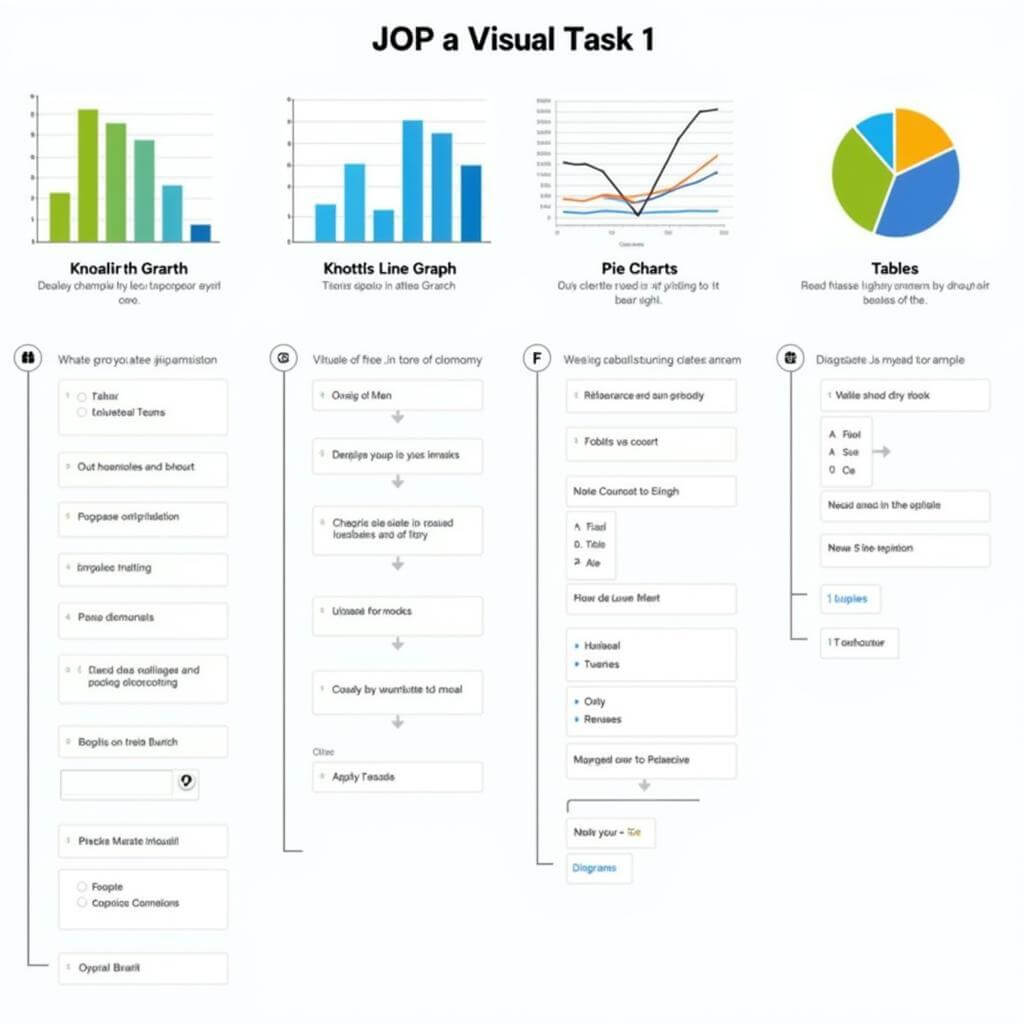Mastering the structure of IELTS Writing Task 1 reports is crucial for achieving a high band score. This guide will provide you with a clear and effective framework to organize your task 1 response, ensuring you cover all necessary elements and present your analysis coherently.
Understanding the Basics of IELTS Writing Task 1
Before diving into the structure, it’s essential to grasp what IELTS Writing Task 1 entails. This task requires you to describe, summarize, or explain visual information presented in a graph, chart, table, or diagram. Your goal is to accurately interpret the data and convey the key trends or patterns in a clear, concise manner.

The Ideal Structure for IELTS Writing Task 1 Reports
Follow this step-by-step guide to structure your IELTS Writing Task 1 response effectively:
- Introduction
- Overview
- Detailed analysis (2-3 paragraphs)
- Conclusion (optional)
Let’s break down each component:
1. Introduction
Your introduction should be concise and to the point. It should:
- Paraphrase the question
- Identify the type of visual information presented
- Mention the main subject or theme of the data
Example:
“The bar chart illustrates the percentage of individuals in different age groups who regularly engaged in online shopping in the United States in 2020.”
2. Overview
The overview is a crucial part of your response, providing a general summary of the main trends or patterns in the data. It should:
- Highlight 2-3 key features or trends
- Avoid specific numbers (use these in the detailed analysis)
Example:
“Overall, it is evident that younger age groups were more likely to shop online regularly, with the highest percentage among those aged 25-34. Additionally, there was a clear declining trend in online shopping frequency as age increased.”
3. Detailed Analysis
This section forms the bulk of your report and should be divided into 2-3 paragraphs. Each paragraph should:
- Focus on a specific aspect or group of related data points
- Include relevant figures and comparisons
- Use appropriate language for describing trends and making comparisons
Remember to use present perfect correctly when discussing changes over time, and focus on improving task 1 data analysis to enhance your score.
Example:
“The age group with the highest percentage of regular online shoppers was 25-34 years old, with 79% engaging in e-commerce frequently. This was closely followed by the 18-24 age group at 74%.”
4. Conclusion (Optional)
While not always necessary, a brief conclusion can provide a final summary or highlight the most significant finding. Keep it short and avoid introducing new information.
Example:
“In conclusion, the data clearly shows a strong correlation between age and online shopping habits, with younger generations being significantly more likely to shop online regularly.”
Key Tips for Structuring Your IELTS Writing Task 1 Report
-
Be concise: Aim for 150-180 words. Quality over quantity is crucial.
-
Use appropriate linking words: Enhance coherence by using transitional phrases to connect ideas.
-
Vary your vocabulary: Write task 1 with better vocabulary to demonstrate your language proficiency.
-
Stay objective: Stick to describing the data without offering personal opinions or speculating on reasons.
-
Practice time management: Allocate about 20 minutes for Task 1 to ensure you have enough time for Task 2.
Dr. Emma Thompson, a leading IELTS examiner, emphasizes:
“The key to a high-scoring Task 1 response lies in its structure. A well-organized report that clearly presents the main trends and supports them with specific data will always impress examiners.”
Common Pitfalls to Avoid
-
Neglecting the overview: This is a critical component that many candidates overlook.
-
Over-describing: Don’t try to describe every single data point. Focus on significant trends and patterns.
-
Using personal language: Avoid phrases like “I can see” or “This graph shows me.”
-
Irrelevant information: Stick to the data presented and avoid speculating or adding external knowledge.
-
Poor time management: Spending too much time on Task 1 can negatively impact your Task 2 performance.
By mastering grammar for high band scores and improving task 1 clarity, you’ll be well on your way to excelling in IELTS Writing Task 1.
Remember, practice is key to perfecting your IELTS Writing Task 1 structure. Regularly analyze different types of visual information and time yourself to improve your speed and accuracy.
FAQ: Structuring IELTS Writing Task 1 Reports
-
How long should my IELTS Writing Task 1 report be?
Aim for 150-180 words. Quality and conciseness are more important than length. -
Is a conclusion necessary in IELTS Writing Task 1?
While not mandatory, a brief conclusion can provide a final summary if time permits. -
How can I improve my overview paragraph?
Focus on identifying 2-3 main trends or patterns without mentioning specific figures. -
Should I describe every detail in the visual information?
No, concentrate on significant trends and patterns rather than every data point. -
How can I effectively manage my time for IELTS Writing Task 1?
Allocate about 20 minutes for Task 1, including 5 minutes for planning and 15 for writing. -
What’s the best way to practice IELTS Writing Task 1 structure?
Regularly analyze various types of visual information, timing yourself and focusing on clear organization.
By following this comprehensive guide, you’ll be well-equipped to structure your IELTS Writing Task 1 reports effectively, enhancing your chances of achieving a high band score.